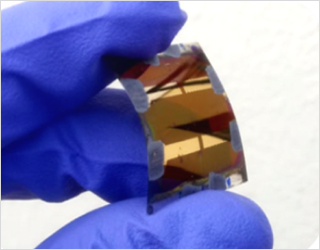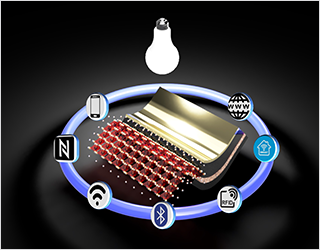Perovskite Photovoltaics on Roll-To-Roll Coated Ultra-Thin Glass as High- Efficiency Flexible Power-Generators for Indoors


A revolution is already under way which includes development of autonomous wireless sensors, low-power consumer electronics, smart homes, domotics and the Internet of Things. All these elements require efficient and easy-to-integrate energy harvesting devices for their power. Billions of wireless sensors are expected to be installed in interior environments over the coming decades.
Indoor photovoltaic (PV) power sources, on ultra-thin curvable substrates, will have the potential to facilitate these technological innovations if they can provide sufficient energy to the electronic components, while remaining small, convenient and economical. This type of energy supply will eliminate the need for batteries (whose replacement causes cost and work), and provide seamless integration.
PV cells must be developed on thin flexible substrates which can deliver excellent performance under indoor artificial lighting with the spectra and illumination levels found prevalently in homes, shops and offices (i.e. 100-500 lux). These values are between 2 and 3 orders of magnitude lower than those found outdoors under the sun (and which are used as standard test conditions for typical solar cells).
An international team with researchers from 3 countries has published the results of their project in an article in Cell Reports Physical Science, the open access journal from Cell Press, which highlights the progress made in advancing these goals.
The team members are from CHOSE (the Centre for Hybrid and Organic Solar Energy), Department of Electronic Engineering, University of Rome – Tor Vergata, from the Hydro Engineering and Agricultural Development Research Group (GHIDA), Faculty of Engineering, Universidad Surcolombiana, Neiva, Colombia, and from the Fraunhofer Institute for Organic Electronics, Electron Beam and Plasma Technology FEP from Dresden, Germany.
They report indoor power generation by flexible perovskite photovoltaic cells (PSCs) manufactured on roll-to-roll ITO (Indium Tin Oxide)-coated ultra-thin flexible glass (FG) substrates with excellent transmittance (> 80%), sheet resistance (13 Ω/square) and bendability, surpassing 1600 bending procedures at 20.5mm curvature. They optimized perovskite photovoltaic cells on ultra-thin flexible glass by incorporating a mesoporous scaffold over SnO2 compact layers delivering a large leap forward in efficiency, reaching 20.6% (16.7 μW/cm2 power density), and 22.6% (35.0 μW/cm2) under 200 and 400 lux LED illumination respectively.
The efficiencies obtained represent the highest reported for any indoor photovoltaic cell technology that is flexible and curvable, as well as surpassing by a 60-90% margin the prior best-performing perovskite photovoltaic cells on flexible substrates. Specific powers in Watts delivered per gram of weight (W/g) are 40-55% higher than their counterparts on plastic PET films and an order of magnitude greater than those on rigid glass.
These figures underline the potential of seamless integration of these ultra-thin and ultra-light energy devices in indoor electronic components. All the active layers of the perovskite photovoltaic cells were deposited at low temperature and by solution processing, meaning that roll-to-roll fabrication of devices on ultra-thin flexible glass can not only be implemented for the ITO layer but also for all other layers by printing techniques in the future.
Additionally, glass, even in its flexible form, creates an exceptionally effective permeation barrier for gasses which are known to degrade perovskite materials, contributing to make this type of technology a prime candidate as key enabling power source for the indoor electronics of the future.
The results are published in Cell Reports Physical Science:
“Perovskite Photovoltaics on Roll-To-Roll Coated Ultra-thin Glass as Flexible High-Efficiency Indoor Power-Generators”, Sergio Castro-Hermosa*, Giulia Lucarelli*, Michiel Top, Matthias Fahland, John Fahlteich, Thomas M. Brown; https://doi.org/10.1016/j.xcrp.2020.100045
About the Centre for Hybrid and Organic Solar Energy (CHOSE), Department of Electronic Engineering, University of Rome – Tor Vergata
The Centre for Hybrid and Organic Solar Energy (CHOSE) was founded in 2006 as a result of the aim of the Lazio Region and the University of Rome Tor Vergata to create a centre of excellence in the field of next-generation photovoltaics. CHOSE is distributed across several laboratories including the new main laboratory within the Campus of Tor Vergata University in Rome. The latter consists of a more than 400 square meter laboratory that houses equipment for the fabrication and characterization of organic, hybrid, dye sensitized and perovskite photovoltaic cells, modules and panels. More than 25-30 researchers work at CHOSE including graduate students, postdocs and staff. CHOSE takes part in many collaborations at the regional, national and international level. The main objectives of CHOSE are to develop fabrication processes for organic and hybrid organic/inorganic solar devices, define processes for industrialization of these innovative photovoltaic technologies, technology transfer and development of photovoltaic applications in collaboration with institutes and companies at both the national and international level.
Source: Centre for Hybrid and Organic Solar Energy (CHOSE), http://www.chose.uniroma2.it/en/
Contact:
Prof. Thomas M. Brown, E-mail: thomas.brown@uniroma2.it
About the Fraunhofer Institute for Organic Electronics, Electron Beam and Plasma Technology FEP
Fraunhofer Institute for Organic Electronics, Electron Beam and Plasma Technology FEP is one out of 72 institutes and research units of the Fraunhofer-Gesellschaft e. V., the largest European institution for applied research [26,600 employees (qualified scientists and engineers); 2.2 billion euros annual research budget]. The core competences of the Fraunhofer FEP are electron beam technologies, vacuum thin film deposition techniques (Sputtering, Evaporation and PECVD) and technologies for manufacturing vacuum-deposited small molecule organic electronic devices in sheet-to-sheet and roll-to-roll processing on pilot scale. Fraunhofer FEP has made substantial contributions for the industrial application of vacuum thin film deposition processes such as reactive-pulsed magnetron sputtering and high-rate evaporation for a wide range of high-volume application products. The institute has strong experience in the field of permeation barrier coating technologies from food packaging grade up to high-end applications using a set of large area roll-to-roll coating machines from lab (200 mm web width) up to pilot scale (600 mm web width).
Website: www.fep.fraunhofer.de/en
Contact:
Dr John Fahlteich, E-mail: John.Fahlteich@fep.fraunhofer.de
Last modified:
 Fraunhofer Institute for Electron Beam
Fraunhofer Institute for Electron Beam